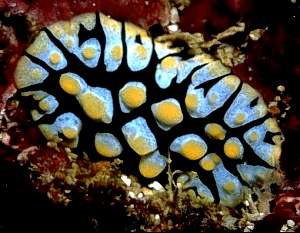
Fryeria rueppelii
Bergh, 1869
Order: NUDIBRANCHIA
Suborder: DORIDINA
Family: Phyllidiidae
DISTRIBUTION
Previously known only from the Red Sea, but see Forum record [#15150] from Gulf of Oman.
PHOTO
Collected subtidally, Red Sea, 1983, dorsal view of ca. 25 mm specimen, Photo: N. Yonow (Brunckhorst, 1993: Plate 4E).
Notes compiled from Brunckhorst, 1993:
External features which distinguish F. rueppelii from other species of Fryeria include its white and yellow-orange tubercles, white marginal semicircles, and, in particular, the yellow-orange edge to the mantle. In contrast, Fryeria bayi is white to cream in colour with fine, pale brown markings. Fryeria guamensis differs in having paler yellow coloration, numerous small tubercles around the mantle margin, and in lacking white semicircles or yellow-orange coloration on the mantle edge.
-
Brunckhorst, D.J. (1993) The systematics and phylogeny of Phyllidiid Nudibranchs (Doridoidea). Records of the Australian Museum, Supplement 16: 1-107.
Rudman, W.B., 1999 (July 15) Fryeria rueppelii Bergh, 1869. [In] Sea Slug Forum. Australian Museum, Sydney. Available from http://www.seaslugforum.net/find/fryeruep
Related messages
Re: Fryeria rueppelii - Gulf of Oman
August 8, 2008
From: Rita Bento

Concerning message #15150:
Hi,
I'm doing the management plan of Dibba Marine Protected Area in Fujairah Emirate, East coast of UAE (Gulf of Oman). I take a lot of pictures during my dives, and this is a nudibranch I found in March in a sand area near a coral reef.
I think this is a Fryeria rueppelii, but I'm not sure. Can you help me identifying?
Locality: Dibba Marine Protected Area, 6 metres, Fujairah, United Arab Emirates, Gulf of Oman, 19 March 2008, sand, near coral reef. Photographer: Rita Bento.
Thanks,
Rita Bento
research@emiratesdiving.com
Bento, R., 2008 (Aug 8) Re: Fryeria rueppelii - Gulf of Oman. [Message in] Sea Slug Forum. Australian Museum, Sydney. Available from http://www.seaslugforum.net/find/21772
Dear Rita,
You don't give an indication of the size of the animal, but if is quite small, it could well be a juvenile F. rueppelii in which the yelow border is not fully developed.
Best wishes,
Bill Rudman
Fryeria rueppelii feeding ?
February 19, 2008
From: Kamal El Tawil

Concerning message #21268:
Dear Bill,
Concerning Annette Kliphuis's message #21268, I am attaching a picture of a Fryeria rueppelii. It is similar to the one on Annette's top picture except that it has an orange edge to its mantle. It seems to be feeding on the soft reddish sponge-like substance ?? As usual, I only took note of it while reviewing my pictures after the dive !
Locality: Dangerous reef, St. John's, 8 Metres, Egypt, Red Sea, 23 July 2007, Offshore reef. Length: 25-30mms. Photographer: Kamal El Tawil.
Kindest regards,
Kamal
www.coralworld.net
kamal@coralworld.net
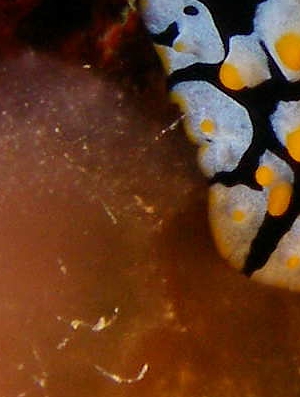
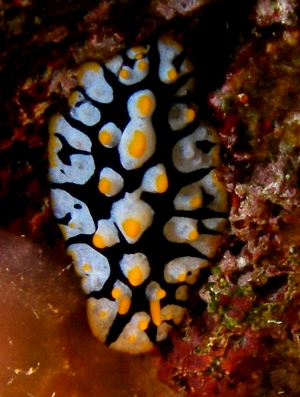
Dear Kamal,
It is possibly a sponge colony, but I am afraid I can't see enough detail to be sure. Phyllidiids all seem to eat a group of spiculate sponges, and unfortunately even with a photo showing the external structure in great detail they are usually more difficult then non-spicuate sponges to identify from photos alone. That is not to say I don't want photos like this because they give us valuable information which can be used when food sponges are identified from actual sponge specimens.
Best wishes,
Bill Rudman
Fryeria rueppelii from the Gulf of Oman
February 15, 2008
From: Yahia Mokhtar
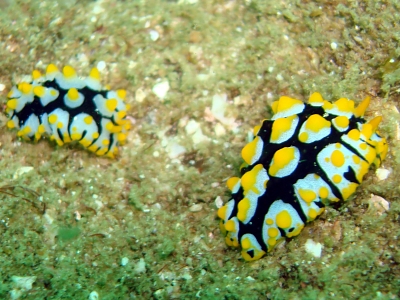
This Nudibranch was photographed two days ago while diving Dibba Rock, UAE. Could it be: Phyllidia varicosa?
Sorry I could not get better focused pictures due to the drift around the rock.
Locality: Dibba Rock, 10m, Fujairah, United Arab Emirates, Gulf of Oman, Indian Ocean, 02 December 2007, gravel. Length: 15 mm. Photographer: Yahia Mokhtar.
Yahia Mokhtar
yahia@adma.ae
Yahia, Mokhtar, 2008 (Feb 15) Fryeria rueppelii from the Gulf of Oman. [Message in] Sea Slug Forum. Australian Museum, Sydney. Available from http://www.seaslugforum.net/find/21262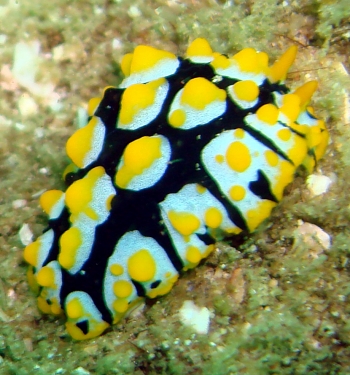
Dear Yahia,
This is Fryeria rueppelii, a phyllidiid nudibranch which until quite recently was known only from the Red Sea, so it is good to get another record of it from further afield.
Best wishes,
Bill Rudman
Fryeria rueppelii from Oman
March 24, 2007
From: Brian Mayes
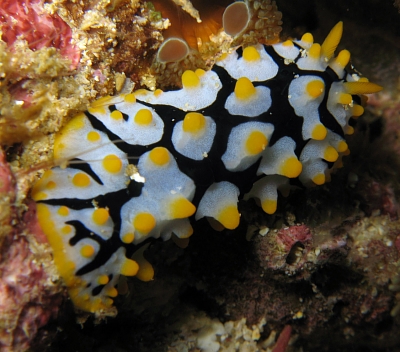
Dear Bill,
Having read the posts concerning the distribution of Fryeria rueppelii outside the Red Sea. I attach a couple of photos of what I think is Fryeria rueppelii taken recently on a dive site called "Bill's Bump" at Fahal Island, near Muscat, Oman.
Locality: Fahal Island, 11 metres, Muscat, Oman, Gulf of Oman, 23 February 2007, Reef. Length: 2 to 3 cm. Photographer: Brian Mayes.
Kind Regards
Brian Mayes
brian@mayescai.freeserve.co.uk
Mayes, B., 2007 (Mar 24) Fryeria rueppelii from Oman. [Message in] Sea Slug Forum. Australian Museum, Sydney. Available from http://www.seaslugforum.net/find/19643
Thanks Brian,
Yes this is that species. It is good to get more data to confirm that it is found outside the Red Sea.
Best wishes,
Bill Rudman
Phyllidia multifaria? from the Red Sea
March 25, 2006
From: Binyamin Koretz
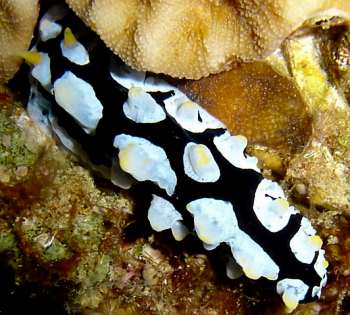
Dear Bill,
Nathalie Yonow, who described this species 20 years ago, was kind enough to identify the attached photos (from a year ago) as Phyllidia multifaria. She also pointed out to me the positioning of the anus, which is quite apparent in these photos, as a good way to distinguish this species from the more abundant and similarly colored Fryeria rueppelii.
Locality: Eilat, Dekel Beach, 24m , Israel, Red Sea (Gulf of Eilat), 25 February 2005, coral reef. Length: ca 4 cm. Photographer: Binyamin and Shulamit Koretz.
Best regards
Binyamin
binyamin@koretz.net
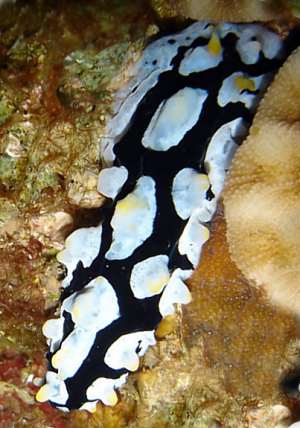
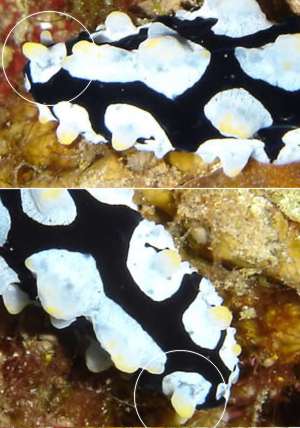
Thanks Binyamin,
I hesitate to disagree with Nathalie but unfortunately I don't think she has correctly identified your animals. In her original description she definitely describes the background colour in P. multifaria to be pink and black, while your animal has a very bluish appearance. The other thing is that unless you actually saw a hole at the end of the 'anal papillae' I am not convinced that the ringed object is an anal papillae. I wouldn't be surprised if it is a yellow tipped tubercle. It is frustrating having only your photos to look at but I would be very surprised if that is an anal papilla.
Unfortunately neither of your photos show the edge of the mantle so I can't see if there is a yellow border which is characteristic of Fryeria rueppelii, but my feeling is that is what this is. If you have photos that show the edge they would be useful. Phyllidia multifaria was considered by Brunckhorst to be a synonym of P. elegans but as your will see on the P. multifaria Fact Sheet its identity is still being debated. However none of the specimens considered to be 'perhaps' P. multifaria have a colour palette or pattern like your animal.
Best wishes,
Bill Rudman
Juvenile Fryeria rueppelii from West Australia
February 11, 2006
From: Kristin Anderson

This is the only one of these I have seen - distinguished by his light blue/white-ish rhinophores. He was very small and in a space where this was the only real viable angle.
Locality: Exmouth; Ningaloo Reef, Exmouth Gulf, Western Australia. Depth: 8 m. Length: under 1cm. 28 January 2006. tidal, silty bottom, limestone & hard coral outcrops. Photographer: Kristin Anderson
Any ideas?
Kristin Anderson
kristin@OceansByAnderson.com
Anderson, K.J., 2006 (Feb 11) Juvenile Fryeria rueppelii from West Australia. [Message in] Sea Slug Forum. Australian Museum, Sydney. Available from http://www.seaslugforum.net/find/15708Dear Kristin,
I think this one just decide to pop out and trick us. I am pretty sure it is an uncoloured juvenile of Fryeria rueppelii, which is the Red Sea species you just sent a message about [#15700]. I can'y say I have much proof to back my identification because we know very little about juvenile colour patterns in phyllidiids, but if you compare the shape of the tubercles and arrangement of the black network pattern they match very well. And I don't know of any of the bluish-grey species which have this colour pattern as adults.
I suspect this is further proof that Fryeria rueppelii is alive and well in Western Australia.
Best wishes,
Bill Rudman
Fryeria rueppelii from Western Australia
February 9, 2006
From: Kristin
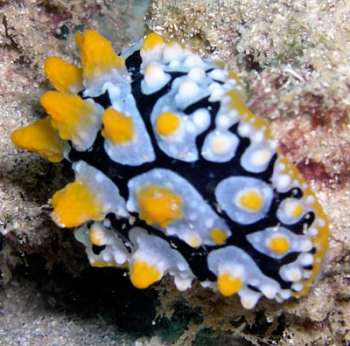
In looking over my nudibranch images I've come across this image that I think may be identified incorrectly. I can't find mention of the orange band around the base of the nudibranch.
Locality: Lighthouse Bay, Ningaloo Reef, Western Australia, Indian Ocean. Depth: 12 m. Length: 4 cm. 2004. linestone and coral reef. Photographer: Kristin Anderson
Appreciate the help.
Kristin Anderson
kristin@OceansByAnderson.com
Anderson, K.J., 2006 (Feb 9) Fryeria rueppelii from Western Australia. [Message in] Sea Slug Forum. Australian Museum, Sydney. Available from http://www.seaslugforum.net/find/15700Dear Kristin,
I'm very glad you had doubts about this animal's identity. If you hadn't had doubts we would still not know that Fryeria rueppelii, which is supposed to be restricted to the Red Sea, can also be found on the other side of the Indian Ocean. As far as I know there is no other species of phyllidiid with this characteristic colour pattern.
This is an exciting extension of the geographic range of Fryeria rueppelii and may cause us to reconsider some of the species in this groups which have been based on quite retsricted geographic distributions.
Best wishes,
Bill Rudman
Fryeria rueppelii - Gulf of Oman
November 2, 2005
From: Adam Skrzypczyk

Dear Bill,
Attached is a photo of what I believe to be a Fryeria rueppelii. You mentioned in other posts that it seems to be restricted to the Red Sea, but given your descripton of the species and it's yellow border I think they may be present in the Gulf of Oman also. This shot was taken in Khor Fakkan, UAE last month. I come across this species quite often at depths between 15 and 25 meters.
Locality: Khor Fakkan, United Aram Emirates, Gulf Of Oman. Depth: 15-25 meters. Length: 2-3 cm. 29 September 2005. large sand-rock area covered with whipcoral. Photographer: Adam Skrzypczyk
Regards,
Adam.
adam_skr@yahoo.com
Adam Skrzypczyk, 2005 (Nov 2) Fryeria rueppelii - Gulf of Oman. [Message in] Sea Slug Forum. Australian Museum, Sydney. Available from http://www.seaslugforum.net/find/15150Thanks Adam,
Until now this species has only been recorded from the Red Sea, so your observation is an additon to our knowledge of the species. Our knowledge on many nudibranch distributions is still very poor so any records you have from along the northern Indian Ocean - Arabian Sea region would be welcome.
Best wishes,
Bill Rudman
Fryeria rueppelii from the Red Sea
September 7, 2005
From: Kamal El Tawil
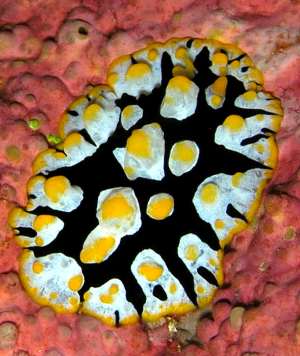
Hi Bill:
Here is a Fryeria rueppelii. Unfortunately I couldn't take pictures from another angle. it was taken in a night dive.
Locality: Dangerous reef, St. John's Reef, near Ras Banas, sthn Egypt. Red Sea. Depth: 6 metres. Length: 4 cms. 27 June 2005. Photographer: Kamal el Tawil
Regards
Kamal
kt@tedata.net.eg
El Tawil, K., 2005 (Sep 7) Fryeria rueppelii from the Red Sea. [Message in] Sea Slug Forum. Australian Museum, Sydney. Available from http://www.seaslugforum.net/find/14691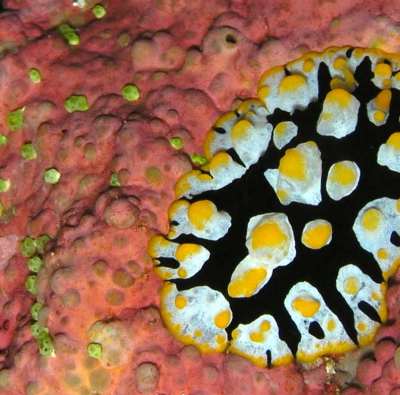
Dear Kamal,
I am interested in the nodulose sponge-like background. Have you any cluse to what it is. If it is a sponge it might be worth looking out for future ocurrences of this nudibranch on the same 'sponge' as we know nothing about its biology
Best wishes,
Bill Rudman
Fryeria rueppelii from Red Sea
July 3, 2003
From: Michael Mrutzek
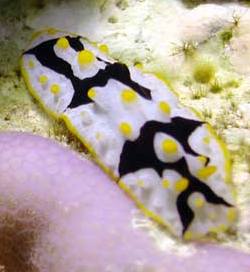
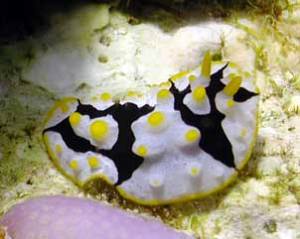
Dear Bill
I am sending some photos of animals I photographed in the Red Sea in May, 2003
Michael Mrutzek
Michael@meeresaquaristik.de
Mrutzek, M., 2003 (Jul 3) Fryeria rueppelii from Red Sea. [Message in] Sea Slug Forum. Australian Museum, Sydney. Available from http://www.seaslugforum.net/find/10037Dear Michael,
This is Fryeria rueppelii. I would appreciate some more precise locality data please, the Red Sea is quite a large place.
Bill Rudman
Fryeria rueppelii from Egypt
September 26, 2002
From: Michael Mrutzek

Dear Bill,
Here is another slug from the Red Sea for use in the Forum.
Data: Reef off Hurghada, Red Sea coast of Egypt, 25m, August, 2002 Photo: Copyright Michael Mrutzek
Michael
Mrutzek@meeresaquaristik.de
Mrutzek, M., 2002 (Sep 26) Fryeria rueppelii from Egypt. [Message in] Sea Slug Forum. Australian Museum, Sydney. Available from http://www.seaslugforum.net/find/8040Dear Michael,
Many of the photos you have sent are of the nudibranch family Phyllididae. These are often quite common, or at least very visible during the day, because they retain noxious chemicals from their sponge food in their own tissues, much like the ovulid in your earlier message. This species is Fryeria rueppelii, a species which is only known from the Red Sea.
Best wishes,
Bill Rudman
Fryeria rueppelii from the Red Sea
April 25, 2002
From: Marina Poddubetskaia
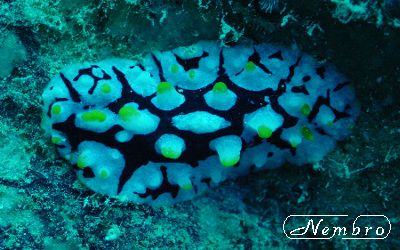
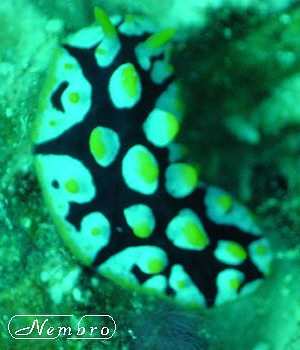
Dear Bill,
Hear are some photos from my trip at the end of March to Egypt. It was a dive cruise at the North of Red Sea, between Hurghada and Sinai mountains.
I think this is Fryeria rueppelii.
UPPER: : about 6-7cm, 18 March 2002, "Le Carnatic" / North Red Sea, 24m depth
LOWER: about 7cm, 20 March 2002, "The Thistlegorm" / North Red Sea, 22m
depth
Strangely, I saw this dorid only on wrecks (?!).
Best wishes,
Marina.
marina.poddubetskaia@francetelecom.com
Poddubetskaia, Marina. , 2002 (Apr 25) Fryeria rueppelii from the Red Sea. [Message in] Sea Slug Forum. Australian Museum, Sydney. Available from http://www.seaslugforum.net/find/6723Dear Marina,
Certqainly the lower photo is F. rueppelii and I guess the upper one is as well but I can't see any sign of the yellow border which is rather characteristic of the species.
Best wishes,
Bill Rudman
Fryeria rueppelii? from Saudi Arabia
November 30, 2001
From: John Chuk

Dear Bill,
After sadly ignoring them for some time I am making an effort to identify the phyllidiids I have on slide. I don't find them at all easy to identify and this is one I'm not sure of. Could it be Fryeria rueppelii?
The specimen was photographed on 16 October 1992 at a depth of 5m on a coastal fringe reef at 'Black Mountain', about 550km south of Jeddah [Saudi Arabia, Red Sea]. It was 25mm in length.
Thanks for all your help.
John.
jchuk@giant.net.au
Chuk, J., 2001 (Nov 30) Fryeria rueppelii? from Saudi Arabia. [Message in] Sea Slug Forum. Australian Museum, Sydney. Available from http://www.seaslugforum.net/find/5753Dear John,
Yes this is Fryeria rueppelii. I am also impressed that you got the spelling correct. Every time I see a species with Rueppel's name in it I have to check the spelling as there have been numerous mispellings in the scientific literature, and I must admit I am never too confident I have it right. [See my comments below].
Cheers,
Bill Rudman
Fryeria rueppelii from Red Sea
February 15, 2001
From: David Harasti
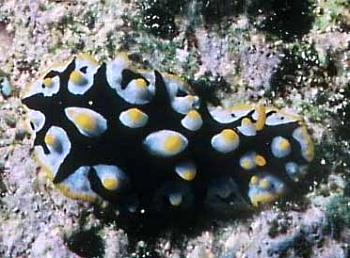
Hi Bill,
Thank you for all your help in the identification of various nudibranchs I have recently sent in. I have another species that I am not sure of. It was found in the Red Sea off Sharm el Sheik. The species was about 4cm long. I think it differs from the pics that I sent in of Phyllidiella pustulosa
Thanks,
David
www2.dynamite.com.au/davidh
davidh@dynamite.com.au
Harasti, D., 2001 (Feb 15) Fryeria rueppelii from Red Sea. [Message in] Sea Slug Forum. Australian Museum, Sydney. Available from http://www.seaslugforum.net/find/3755Dear Dave,
This is an interesting find, I think it is the first record on the Forum of Fryeria rueppelii. This species appears to be restricted to the Red Sea.
Bill Rudman
Spelling of Fryeria rueppelii
March 1, 2000
From: Erwin Koehler

Dear Bill,
Can you tell why Fryeria rueppelii Bergh, 1869 is spelled with one 'l'? I attach a file with the right spelling, because I think computers all over the world don't work with the German alphabet (my own name is a good example). If it is named in honour of Rueppell it should be spelled with 2 'l's - posthumous he should be glad that the name is not Ruepel - the German meaning of this is boor, rowdy.
Erwin Koehler
Medslugs.Koehler@t-online.de
Erwin Koehler, 2000 (Mar 1) Spelling of Fryeria rueppelii. [Message in] Sea Slug Forum. Australian Museum, Sydney. Available from http://www.seaslugforum.net/find/1998The apparently incorrect spelling of the name is based on two articles of the International Code of Zoological Nomenclature. Firstly names with marks such as 'ü' have to be transliterated into standard alphabet as you have illustrated above. This Rule existed long before computers but I must admit converting your Köhler to Koehler so that search engines will find your name.
The second point is that the spelling of published names can only be changed in exceptional circumstances. Basically for a mispelling to be corrected there must be evidence within the paper where the name is introduced to show that a mispelling has occurred. For example if an author writes "I name this species Doris morgaretae after my wife Margaret, there would be grounds to change the name to D. margaretae on the grounds of a mispelling or typographical error. However if the author had just said "I name this species after my wife" without mentioning her name, then there would be no grounds for amending the spelling at a later date.
In the case of Fryeria rüppelii there is no indication of a mispelling in the original description. Here is a paraphase of part of a submission to the International Commission to clarify and stabilise the name Fryeria rüppelii as the type species of Fryeria. [Brunckhorst, Rudman & Willan (1989) Case 2682 Bulletin of Zoological Nomenclature 46(3): 161-164], where this question was discussed:
"The name Fryeria rüppelii was proposed by Bergh (1869). The spelling of the specific name has been inconsistent and the following variations have been used: rüppelii, rüppellii, rüppeli, ruppelli, ruppelii, rueppelli. Bergh (1869) spelt the name rüppelii and this name must be corrected to rueppelii according to the International Code of Zoological Nomenclature. The species rüppelii is named after Rüppell, but Bergh consistently misspelt his name 'Rüppel' in his 1869 paper. It is therefor not permitted to amend the name to rueppelli as there is no indication in the paper of a spelling error".
Under the Rules if Bergh had said he was naming the species Fryeria rüppelii in honour of Eduard Rüppell then we could change the spelling. I know it sounds silly but it saves uncertainty and later arguments about spelling of names.
Best wishes,
Bill Rudman.
